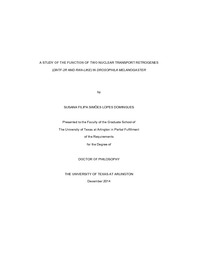| dc.description.abstract | The genetic information, DNA (deoxyribonucleic acid) and RNA (ribonucleic acid), is the hereditary material that forms the basis for the origin and evolution of life. These molecules encode and store information that can be copied, read, mutated, recombined and selected, providing necessary conditions for the evolution of the diversity of life on earth. With my project I contribute to the understanding of how one class of mutations, namely gene duplication, contributes to the functional differences between species. It has been observed that many new duplicate genes originate for testis functions; not only in the Drosophila genomes but other organisms' genomes including humans. However, we still need to understand what are the selective pressures that promote those duplications and for what functions. I have focused my studies on two gene families of nuclear transport proteins in Drosophila (Dntf-2 and Ran gene families) because they have given rise to testes gene duplicates that evolve under positive selection recurrently. Dntf-2 and Ran physically interact and are involve in nuclear transport.I, first, provide an update on the number of recurrent duplications of Dntf-2 and Ran using the 22 Drosophila genomes that are currently available. This new data shows a minimum of 6 duplication of Dntf-2 in the Drosophila genus and 10 duplications of Ran. We looked at DNA- and RNA-mediated duplications but, interestingly, find that between 80% and 90% of the duplications occurred by means of an RNA intermediate while RNA-mediated duplications are a small fraction of all the duplicates found in the Drosophila genomes. RNA-mediated duplications do not duplicate the regulatory regions of parental genes. So, I also study the origin of the regulatory regions of two of the retroduplicated genes that are in D. melanogaster (Dntf-2r and Ran-like). I show that the testis regulatory regions are short and potentially easy to acquire after RNA-mediated duplication. Interestingly, in the case of Dntf-2r, I demonstrate that the regulatory region was in the genome before the insertion, likely driving the testis expression of a non-coding RNA. So, we propose that retrotransposition in the male germline to regions of open chromatin helps retrogenes directly acquire testis expression potentially explaining why we see an excess of duplicates originating through this mechanism. To elucidate the reasons for the recurrent duplication of Dntf-2 and Ran, we have taken a functional approach and decided to study the function of two of the retroduplicated genes (Dntf-2r and Ran-like) that by being in D. melanogaster are amenable to those analyses. We have gained tremendous understanding about those genes function in spermatogenesis and revealed that they also have somatic functions. Both genes appear to have an array of functions from spermatocytes onwards related to nuclear transport, nuclear membrane assembly, and microtubule organization during chromosomal segregation, and during sperm head and tail elongation as interpreted from the localization of the fusion proteins we have generated. The deficit of Dntf-2r or Ran-like achieved by triggering RNAi in male germline reveals strong effects in male fertility and an array of cytological abnormalities at different stages during sperm production. In the soma, RNAi of Dntf-2r or Ran-like affects viability due to the expression of those genes in imaginal discs, salivary glands, accessory glands and prothoracic gland. This data reveals that, contrary to what we initially thought, these retroegenes appear to have an important function in somatic cells and not just in germline cells. While it was initially hypothesized that Dntf-2 and Ran duplicate recurrently to suppress selfish elements in male germline (i.e., transposable elements and meiotic drive systems that often evolve in or horizontally transfer to this tissue), the myriad of functions that they currently have does not support this hypothesis. If Dntf-2 and Ran were duplicated in D. melanogaster to suppress selfish elements, we infer that they have gained additional functions after. Some of the current functions (e.g., a function in sperm tail elongation inferred from protein localization) could have evolved as a response to male-male competition and it could be that those were actually the pressures that gave rise to those gene duplicates. | |


